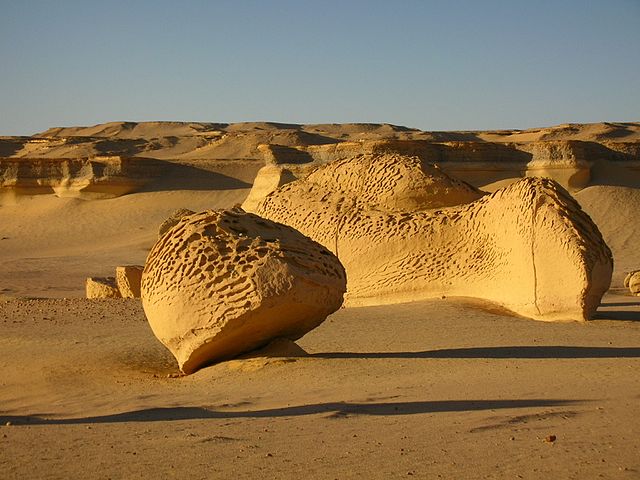Wd al-tn, also known as the “Valley of the Whales,” is a paleontological site in the Faiyum Governorate of Egypt, about 150 km (93 mi) south of Cairo. Arabic pronunciation: [wa.di el.it.ae] (listen). It was named a UNESCO World Heritage Site in July 2005 because to its abundance of fossilized archaeoceti whales, one of the earliest species of whales (a now extinct sub-order of whales). The discovery provides proof that one of the most puzzling aspects of whale evolution—the whale’s transformation from a land animal to an ocean-going mammal—can be explained. The quantity, concentration, and quality of these fossils, along with their accessibility and location in a picturesque and protected area, are unmatched anywhere else in the world. Consequently, the valley was added to the UNESCO World Heritage List in 2005.
Even while the fossils discovered at the site may not be the earliest, their high local concentration and level of preservation are such that even some stomach contents are complete. Its reason for being listed as a Heritage site is furthered by the existence of fossils of other early species such sharks, crocodiles, sawfish, turtles, and rays at Wd al-tn, which make it feasible to reconstruct the local environmental and ecological circumstances of the time.
In the winter of 1902-03, the first whale skeletons made of fossilized bone were found. They garnered relatively little attention over the following 80 years, largely as a result of how challenging it was to get to the location. Due to the increased availability of four-wheel drive vehicles in the 1980s, interest in the location increased once more. As curiosity grew, the location was frequented by fossil hunters, and numerous bones were taken, leading to calls for the site to be preserved. While preserving some of the primitive features of tooth and skull structure, the remnants show the usual streamlined body form of modern whales. The longest specimen, which measured up to 21 meters in length, had forelimbs with well-developed five-finger flippers and unexpectedly had rear legs, feet, and toes that had not previously been seen in any archaeoceti. They had a serpentine shape and devoured meat. A few of these skeleton remains are visible, but the most are progressively being exposed by erosion while being shallowly buried in sediments. Evidence of coastal marine life dating back millions of years can be found in Wd al-Tn.
At the location Fossils, the skeletons of whales like Basilosaurus were found.Dorudon atrox skeleton, mostly complete, discovered at Wd al-Tn and on exhibit at the University of Michigan Museum of Natural History.
The evolution of whales is one of the iconic shifts that characterize the story of life on Earth, and Wd al-Tn is the most significant location in the world to illustrate this transformation. It beautifully depicts their shape and way of life as they shift from being land animals to living in the sea. The quantity, concentration, and quality of its fossils, as well as their accessibility and location in a beautiful and protected terrain, surpass the values of other comparable locations. remarkable collection of shark teeth, sirenians, and reptiles from the Gehannam Formation, as well as petrified remains of Archaeoceti (primitive whales marking the transition of cetaceans to marine life) (40–41 million years ago). The strata at Wd al-tn date back to the Middle Eocene era and cover an area of 200 km2 (77 sq mi). They are rich in vertebrate fossils. There are many fossils, and they frequently exhibit superb preservation. The skeletons and bones of whales and sea cows are the most noticeable fossils, and there are over a hundred known examples of each. 1500 marine vertebrate fossil skeletons make up the unusually high concentration of fossil whales in Wd al-tn (Whale Valley), which is a relatively small area.
Whale fossils range from individual bones to complete skeletons, and some partial skeletons are currently on display in the park’s public area. The enormous Basilosaurus and the smaller (3- to 5-meter) Dorudon are the two common whales. The remains of at least two more species are more uncommon. The whales have diminutive hind limbs, which are not present in contemporary whales, as well as a robust head with teeth that resemble those of carnivorous land mammals.
Three species of sirenians, sometimes known as sea cows, are represented by their skeletons as other mammals. Like whales, these were entirely marine animals. They exhibit primordial characteristics not found in contemporary species and have teeth that indicate they may have grazed on seagrass and other marine plants. Additionally, bones from the extinct Moeritherium elephant have been found.
The fossilized remains of crocodiles, sea turtles, and sea snakes are all examples of extinct reptiles. There are many different kinds of bony fish, sharks, and rays represented, however the majority of the fossils are small, isolated teeth that are rarely noticeable.
The rostra and pegs of sawfish are among the larger fish fossils; a 1.8-meter-long sawfish rostrum is on display in the park. While they are less frequent in other rocks than the primary rocks that contain whale fossils, it is typical to find a wide diversity of fossil shells in various fallen rocks. Nummulite fossils in the shape of discs are widespread and frequently cover the desert floor. The park has a sizable wood that is covered in tubular shipworm fossils. There are also known fossils of seagrass. [Reference needed]
Dolphin Valley
In 2021, scientists in Wd al-tn identified the earliest pelican fossil ever found, which dates from the late Eocene.
Geology
The beauty is a result of the valley’s geology, which has produced stunning cliffs and buttes as a result of wind and water erosion. There are three primary rock units made up of Middle to Late Eocene-aged rocks at Wd al-tn. Open sea mudstones, which make up the Gehannam Formation, are mainly found on the gentler terrain to the east of the public park. The Birket Qarun Formation is the geologic formation that is home to the majority of the whale remains. The majority of the cliffs and buttes are made of yellowish open marine sandstones. A white layer full of well-preserved animal burrows (formerly believed to be mangrove roots) and a layer of black mudstone on top of that break up the monotony of these sandstones. The Gehannam Formation mudstones take the place of the Birket Qarun Formation cliffs as one travels eastward, showing a change in sea depth from shallower to deeper. The higher cliffs’ tops are located in the Qasr el Sagha Formation, which is made up of limestones rich in shells and black mudstones that alternately depict a lagoonal environment.
Wildlife
Along with sand dunes, 15 species of desert plants, and a variety of wild mammals, such as the Egyptian wolf, red fox, African leopard, Egyptian mongoose, African wildcat, and dorcas gazelle, Wd al-Tn is also home to a number of other species of plants and animals. The most frequent mammal sightings occur at night, when fennec foxes frequently stop by the campsite. Additionally, Wadi El Rayan’s lakes are home to 36 species of breeding birds and 19 species of reptiles. [Reference needed]
Due to the track’s lack of pavement and passage through unmarked desert sands, only 1,000 tourists each year enter Wd al-Tn by 4WD. Foreigners constitute the majority of Wd al-visitors, tn’s and they frequently camp there on weekends during the winter. The Wadi El Rayan Protected Area includes Wd al-Tn, thus the same protection management plan limits visits to organized guided tours along a designated track. The region is starting to see the growth of sustainable tourism, and camel or foot treks are starting to take the place of 4WD excursions.
Walkways between the main fossils have been set out, and modest shelters have been constructed, as part of Wd al-tn has been converted into a tourist attraction. Tourist groups now frequently visit this public park, and there is a small campground there.
The valley is situated in the shadow of Garet Gohannam, often known as “the Mountain of Hell.” The mountain appears to be blazing with an unsettling red light under the light of the setting sun.

